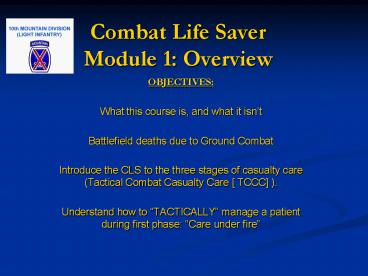Combat Life Saver Module 1: Overview - PowerPoint PPT Presentation
1 / 14
Title:
Combat Life Saver Module 1: Overview
Description:
Combat Life Saver Module 1: Overview OBJECTIVES: What this course is, and what it isn t Battlefield deaths due to Ground Combat Introduce the CLS to the three ... – PowerPoint PPT presentation
Number of Views:735
Avg rating:3.0/5.0
Title: Combat Life Saver Module 1: Overview
1
Combat Life Saver Module 1 Overview
- OBJECTIVES
- What this course is, and what it isnt
- Battlefield deaths due to Ground Combat
- Introduce the CLS to the three stages of casualty
care (Tactical Combat Casualty Care TCCC ). - Understand how to TACTICALLY manage a patient
during first phase Care under fire
2
Combat Lifesaver What is that?
- The Combat Lifesaver is a Non-Medical soldier
trained to provide battlefield emergency care as
a secondary mission. He does NOT replace the
Combat Medic. His PRIMARY mission is his COMBAT
mission. - Who is the biggest lifesaver on the battlefield
today? You! The Primary person at the point of
wounding. - What is the BEST medicine on the battlefield?
Motrin? An IV? - No! The best medicine is Superior Firepower
3
What this course IS about
- Teaching basic, practical life-saving techniques
that all non-medical soldiers can use on the
battlefield - Teaching not only the what but the why
- Breaking some bad habits that we (the medical
world) and the Army (i.e. JRTC) have taught you - Keeping you doing what you are trained to do
4
Deaths due to ground combat
- In Iraq and Afghanistan today, if a soldier makes
it to a MTF (Medical Treatment Facility) alive
from the point of wounding, they stand a 96
chance of living. TCCC doctrine has lowered the
Died Of Wounds (DOW) rate on the battlefield. - 90 of all combat deaths occur on the battlefield
before definitive treatment is reached ( example,
a MTF ). Most of these deaths are Un-Avoidable,
and CANNOT BE PREVENTED by you or a medic. - What are the major injuries we can impact at our
level? Injuries which soldiers are dying from
that can be prevented?
5
WHAT CAN WE DO??
- Stop severe bleeding (Hemorrhaging)
- Relieve Tension Pneumothorax
- Restore airway
- SO WHAT ARE THE STAGES OF TACTICAL COMBAT
CASUALTY CARE? WHAT DO I DO IN EACH?
6
(No Transcript)
7
TACTICAL COMBAT CASUALTY CARE (TCCC)
- CARE UNDER FIRE
- In this phase, you are under direct hostile enemy
fire, and attention must be directed to
overwhelming the enemy, and ONLY concentrating on
major bleeding noticed - If major bleeding is noticed on a casualty, and
you can reach them safely, apply a tourniquet,
and then rejoin the fight. If the casualty can
continue to fire as well, they should be
encouraged to do so. - If you cannot reach the casualty because of
direct hostile fire, do not expose yourself. Tell
soldier to lie still, and return fire. Extract
him when enemy is overwhelmed.
8
Care under fire ( contd)
- Remember you and the casualty are still under
effective hostile enemy fire - Return fire as directed or required before
providing medical treatment - Determine if casualty is alive or dead.
- Provide tactical care to the live casualty.
- Only critical equipment gets secured with casualty
9
Care Under Fire (Contd)
- Check Casualty for Bleeding ( If you are able to
do so at this time this should take no more than
45 secs-1 minute) - If life-threatening bleeding from an extremity is
present, then place a Tourniquet on immiediately
(USE THE CASUALTIES TOURNIQUET FROM HIS IFAP PACK)
10
TACTICAL FIELD CARE PHASE
- In this phase, direct hostile enemy fire has been
suppressed, or you and the casualty are in place
of moderate safety. - In this phase you have the time to conduct your
secondary mission of treating this casualty. - Recheck bleeding control measures (Consider
placing a Pressure bandage on wound and removing
Tourniquet).
11
Tactical Field Care Phase (Contd)
- Determine Casualties level of consciousness
- Check for open chest wounds
- Open and secure casualties airway
- Take measures to treat for shock
- Treat other injuries
12
Tactical Field Care Phase (Contd)
- COMMUNICATE!!!!
- Brief your unit leader on casualties injuries and
condition - Initiate a Field Medical Card
- Monitor the Casualty
- Recheck on the casualty every 5 minutes.
- Recheck casualties breathing, bandages, and IV
site.
13
COMBAT CASUALTY EVACUATION CARE
- If casualty is being evacuated, prepare them for
evacuation. - Cover them with a blanket to keep them warm
- Prepare and transmit a 9 Line Medevac request
- If casualty has to be moved, prepare the SKEDCO
litter, or TALON II litter. - If casualty is going via non-medical vehicle,
arrange vehicle for their transport.
14
QUESTIONS?































